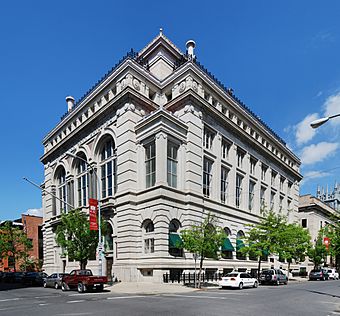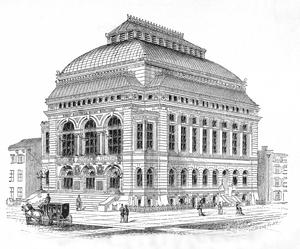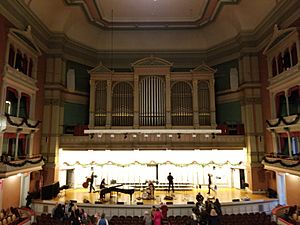Troy Savings Bank Music Hall facts for kids
|
Troy Savings Bank Music Hall
|
|
|
U.S. Historic district
Contributing property |
|

Looking up at the Troy Savings Bank from the street
|
|
| Location | 32 Second Street, Troy, NY |
|---|---|
| Area | 1 acre (0.40 ha) |
| Built | 1871-75 |
| Architect | George B. Post |
| Architectural style | Second Empire, Italianate |
| Part of | Central Troy Historic District (ID86001527) |
| NRHP reference No. | 89001066 |
Quick facts for kids Significant dates |
|
| Added to NRHP | April 11, 1989 |
| Designated NHL | April 11, 1989 |
| Designated CP | August 13, 1986 |
The Troy Savings Bank Music Hall is a famous place for performances in Troy, Rensselaer County, New York. It is known for its amazing sound quality, also called acoustics. It also has a very special Odell concert organ.
A group that doesn't make a profit runs the music hall. In 1989, it was named a National Historic Landmark. This means it's a very important building because of its beautiful design. It is one of the best old auditoriums from the 1800s that is still standing.
Contents
History of the Music Hall
The Troy Savings Bank started in 1823. In 1870, it moved to its current spot. The bank wanted to thank the community for their support. So, they decided to build a music hall on the upper floors of their new building.
In the early 1900s, many famous artists performed here. These included singers like Lillian Nordica and musicians like Sergei Rachmaninoff. It was a common stop for musicians on their tours across America.
Later, in the 1930s and 1940s, more great artists played at the hall. These included Vladimir Horowitz and Yehudi Menuhin. The hall was a very popular place for concerts.
There was a funny tradition before each show. The Fire Marshal would come on stage. He would tell everyone, "No smoking in the Hall! If you need to smoke, you can go outside at half time." This was because of old safety rules.
After World War II, Troy became less wealthy. The bank also faced challenges. Many people worked hard to save the bank and the music hall from closing. They thought about making a museum downstairs. They also thought about renting the hall to local colleges.
In 1979, a group of citizens started the Troy Savings Bank Music Hall Revitalization Committee. With help from the bank, city, and county, the Troy Savings Bank Music Hall Corporation was formed. This is a non-profit group that still rents the hall today. They started their ownership with a concert by the Benny Goodman Band in 1980.
The building is also part of the Central Troy Historic District. This means it helps make the whole area special.
How the Hall Was Designed
The design for the building was chosen by George B. Post. He was a skilled architect who knew how to make metal look like stone. This helped keep the building's cost within the bank's budget. Post had studied architecture in the mid-1800s. He became a respected architect in New York City.
Post liked fancy and detailed styles. You can see this in the building's many decorations. Construction on the bank's new property began in July 1871. It was at the corner of State and Second Streets.
The building was finished in April 1875. It cost about $435,000. It is a huge six-story building that stands out in the neighborhood. The bank offices took up about one-third of the first floor. The rest was rented to other businesses. These included an insurance company and a bus terminal.
Above the bank was the Music Hall itself. It is 106 feet long and 69 feet wide. It is also very tall, reaching 61 feet high.
Inside the Hall
Concert-goers entered through grand granite stairs. These stairs ran across the front of the building. Inside, there were box offices on the left and right. A center stairway led up to the main hall.
The main seating areas, called Parquet and Dress Circle, are still reached by this center staircase. Iron staircases on the sides led to other seating areas. These included the upper boxes, the balcony, and the gallery. The hall can seat 1,253 people. The seating has not changed since it was built. Post designed all the staircases himself.
Beautiful paintings, called frescoes, decorated the walls and ceiling. These were made by a firm from New York City. The frescoes above the stage were covered in 1890. This happened when a large organ was added.
Most of the original frescoes can still be seen. However, the ceiling frescoes were repaired in 1930. This was when the main chandelier was replaced. The first chandelier was amazing. It had 14,000 hand-cut French prisms. These caught the light from 260 gas burners.
In 1923, the chandelier was changed to use electricity. The rest of the lighting was changed in 1929. This happened after a dancer's headdress caught fire from a gas lamp. The fire marshal ordered the change for safety. The new frescoes from 1930 showed the names of famous composers. These included J. S. Bach and Haydn. The chandelier still has to be raised and lowered by hand.
The building was named a National Historic Landmark in 1989.
The Organ
The organ at the Troy Savings Bank Music Hall is very old. It was built in 1882 by J. H. & C. S. Odell. It was first put in the home of a rich man named William Belden. The organ cost $12,470 back then.
The Troy Savings Bank bought the organ in 1889. It was moved and set up in the Music Hall in 1890. The first time the organ was played in the hall was on October 20, 1890. The organ was used until the 1960s, but then it broke down.
In 2006, people started working to fix the organ. The Organ Historical Society helped lead this effort. Volunteers worked for many weeks to make the organ play again. The restored organ was shown off at a big event in 2006.
Amazing Acoustics
Acoustics is how sound travels and sounds in a room. The Troy Savings Bank Music Hall has amazing acoustics. Many things help with this.
- It has a narrow, shoebox shape.
- Sound bounces off the side walls quickly.
- It has a very tall ceiling.
- There are 1,180 padded wooden seats.
- The area under the balcony is not very deep.
- The walls are made of thick plaster.
- There are many fancy decorations.
- The organ area helps project sound.
Because the hall sounds so good, it is often rented for concerts and to make recordings.










